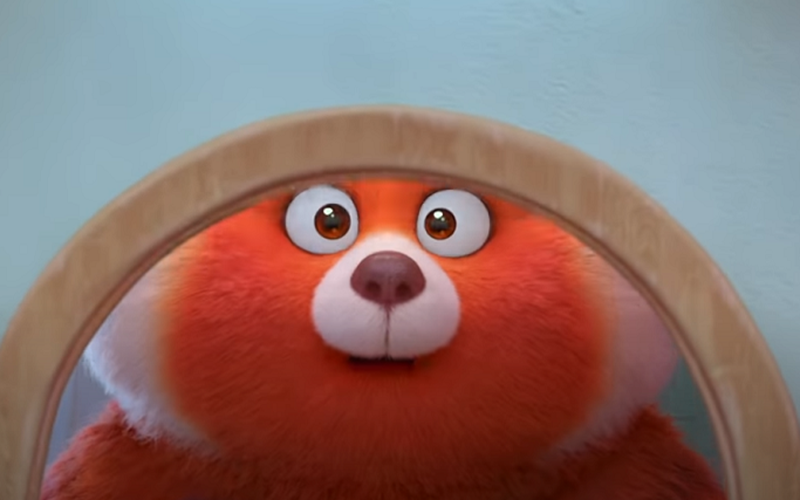

While on a recent family vacation, my kids noticed the promotion of Disney Pixar’s newest animated film, Turning Red. We knew nothing about it prior to our trip, and I thought nothing of it until I saw a couple of cautionary Facebook posts from some mom friends who were blindsided and outraged by the film’s content and message. The film now had my attention.
So one night last week after we were back home and the kids were snuggled in bed, I decided to watch the movie myself to see what all the hullabaloo was about. To say I was bothered by what I watched is an understatement. And to stay quiet about what I saw would be irresponsible on my part as a mother, as a pastor’s wife, and ultimately as a believer.
The content and message of the film are wrong on so many levels; I don’t even know where or how to begin processing it all and putting it into words. I won’t be able to adequately cover it all. So I’m going to use other sources to help me articulate what I feel all parents should know about Turning Red, now streaming on Disney+.
As described by the streaming platform, “Turning Red introduces Mei Lee, a confident, dorky teenager torn between staying her mother’s dutiful daughter and the chaos of adolescence. Her protective, if not slightly overbearing mother, Ming, is never far from her daughter – an unfortunate reality for the teenager. And as if changes to her interests, relationships, and body weren’t enough, whenever she gets too excited, she ‘poofs’ into a giant red panda” – a generational curse in her family.
According to director Domee Shi, Mei’s transformation into a red panda [pictured above] is a “metaphor for magical puberty.” The movie is very forthright about female coming of age. Within the first few minutes of the film, Mei undergoes a sudden physical transformation and dashes into the nearest bathroom. Hearing her daughter screaming and sobbing, Mei’s mother knocks on the door and nervously asks, “Has … has the red peony blossomed?” While Mei’s mother assumes that her daughter has started her period for the first time, it was actually Mei’s first transformation into a red panda.
However, puberty is the overarching theme of the film, and here is an excerpt from the secular Slate.com that clearly describes the animated film’s frankness about sex and sexuality:
“[The] heroine’s uncontrollable and often embarrassing girl-to-panda transformation is the clearest movie metaphor for the onset of a young woman’s menstrual cycle. … Mei starts off the film as a buoyant, irrepressible force of nature, a livewire math nerd whose desire to satisfy her family’s high expectations is at war with her eagerness to sample the pleasures of teenage life. She even—in perhaps the most overt reference to sex yet seen in a Pixar film—draws pictures of herself in a clinch with her thirst object in a secret notebook she keeps under her bed. …
There aren’t many [supposedly] family-friendly movies that have taken on this kind of hot-button subject matter: the at times cruel power struggle between mothers and daughters, the awkwardness of early physical maturation, the way pop music and celebrity crushes can serve as vectors for burgeoning sexuality. (One climactic confrontation between Mei and Ming has the panda-fied Mei twerking her plushy tail in her horrified mother’s face while declaring ‘I like to GYRATE!’)”
If this isn’t enough to convince you that Turning Red should never be turned on in your home, let’s look at what The Gospel Coalition (TGC) calls the film’s
“wrongheaded central message [proclaimed] under the guise of empowerment: embrace who you are, even your reckless vices and dangerous impulses, and don’t let anyone stop you.”
Brett McCracken of TGC explains the movie’s message like this:
“The story plays with the old Jekyll and Hyde trope (or Bruce Banner and the Hulk). … [But this time] it’s not about pitting our inner Jekyll against our inner Hyde; it’s about embracing both as essential sides to the authentic self. It’s the natural arc of our modern age: from black and white to everything gray; reframing dysphoria as euphoria.”
And here is where the message becomes a theological issue. No doubt there is truth to our internal Jekyll/Hyde conundrum. Our flesh is constantly at odds with our spirit. Paul talks about this in Romans 7 where he admits that he doesn’t understand his own actions, he does what he doesn’t want to do. He also talks about this conflict in Galatians 5 and Ephesians 4.
“What you’ll not find in the New Testament, however, is an encouragement to just resign yourself to these ‘two sides of yourself’ and embrace them as both essential aspects of ‘who you are,’” McCracken explained. “The Bible never encourages us to accept the beastly sides of our fallen natures as sanctified goods, as if the Hyde side of our nature is somehow part of a hallowed ‘true self’ that we shouldn’t hide but rather let loose without shame.
“Yet our culture today tells us to do precisely this,” McCracken added. “And so does Turning Red.”
In fact, the movie ends with Mei proudly admitting that we all have an inner beast – “a messy, loud, weird part of ourselves hidden away” – that we don’t … but should … let out. But Mei let hers out and she challenges viewers to do the same.
“‘Embrace the mess’ may be a cute coffee mug slogan, but if it justifies sinful behavior under the banner of ‘authenticity’ and expressive identity, it’s a bankrupt moral philosophy that will shipwreck your life,” McCracken said.
Mei’s rebellious nature is glorified throughout the entire film from start to finish. The movie literally starts with the teen girl talking about how she was taught to honor her parents but there comes a point in life when honoring them keeps you from honoring yourself. Toward the end of the film, when Mei’s mom objects to her going out in public with her panda tail and ears showing, Mei looks at her mom and says, “My panda, my choice, Mom!” – an obvious nod to the pro-abortion slogan, “my body, my choice.”
I could literally go on and on about the problematic elements of Turning Red. There is not even room here to talk about the ancestral communication with the dead that takes place in the film along with some strange ceremonial type of exorcism. There are also subtle and not-so-subtle nods to the LGBTQ lifestyle.
All in all, Turning Red is a complete mess with a message that will mess up our kids. In fact, McCracken calls the movie’s message not just bad but criminal, not empowering but endangering.
“[M]y advice on Turning Red is to turn it off,” McCracken said.
And, obviously, I agree!

